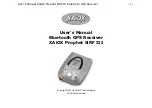
LBA-Anerkennung:
Herstellungsbetrieb gemäß EASA Ref. DE.21G.0115 Instandhaltungsbetrieb gemäß EASA Ref. DE.145.0305
Technische Beschreibung
Verwendungszweck:
Skalenausführung:
Prinzipielle Arbeitsweise:
Technische Daten
Gewicht
Anzeigefehler:
Anzeigeverzögerung:
Volumen des
Ausgleichsgefäßes:
Vibrationsfestigkeit:
Verwendungsgrenzen:
Stauscheiben-Variometer zur Messung der Vertikalgeschwindigkeit
von Segelflugzeugen, Motorseglern und Ballonen.
5 StV und 5 StVM: 270° - Skala mit linearer Teilung
5 StVL und 5 StVLM: 270° - Skala mit logarithmischer Teilung
Die Arbeitsweise beruht auf der Messung der Ausgleichsströmung, die
bei Luftdruckänderungen zwischen Ausgleichsgefäß und statischer
Druckentnahmestelle auftritt.
5 StV und 5 StVL: 0,25 kg
5 StVM und 5 StVLM: 0,24 kg
5 StV und 5 StVM: siehe Tabelle
5 StVL und 5 StVLM: 0,9 Liter
.
Im Frequenzbereich von 5 bis 50 Hz treten bei translatorischen Schwin-
gungen keine Resonanzen auf. Nullpunktdrift: max. 0,1 m/s.
Keine Ablenkung der Kompassnadel bei beliebigem Abstand Vario-
meter/Flugkompass.
Das Variometer ist unbegrenzt überlastbar; abrupte Druckänderungen
müssen vermieden werden.
Maximale Betriebshöhe: 12.000 m
Betriebstemperaturbereich: -30°C bis + 50°C
5 StV und 5 StVM: siehe Tabelle
5 StVL und 5 StVLM: Bei einer sprunghaften Änderung der Vertikal-
geschwindigkeit vom Skalenendwert auf 0 geht die Anzeige in 1 Se-
kunde auf 10% des ursprünglichen Wertes zurück.
a) bei Raumtemperatur ± 10% im gesamten Anzeigebereich
b) bei -30° C bis +50°C ± 15% im gesamten Anzeigebereich
EINBAU- UND WARTUNGSANWEISUNG FÜR DIE STAUSCHEIBEN-VARIOMETER
5 StV, 5 StVM, 5 StVL und 5 StVLM
Ausgabe: Januar 2015
INSTALLATION AND MAINTENANCE INSTRUCTIONS
FOR VANE-TYPE VARIOMETERS Type 5 StV, 5 StVM, 5 StVL and 5 StVLM
Issue: January 2015
Magnetische
Beeinflussung:
Überdruckfestigkeit:
5 StVM 5 - 3
S Nr. 5453
5 StV 5
S Nr. 5251
Gebr. Winter GmbH & Co. KG
Hauptstraße 25 · D-72417 Jungingen
T49 (0) 74 77 2 62 + 15 12 63
T49 (0) 74 77 10 31
e-mail: [email protected]
Internet: www.winter-instruments.de
INSTALLATION INSTRUCTIONS
The mounting dimensions of the vane-type variometers types 5 StV and 5 StVL correspond to the
so-called large standard. The diameter of the hole in the instrument panel is 80 mm, the hole circle
diameter on the mounting flange is 89 mm. The mounting dimensions of the van-type variometers
types 5 StVM and 5 StVLM correspond to the so-called small standard. The diameter of the hole in
the instrument panel is 57 mm, the hole circle diameter on the mounting flange is 66,7 mm. M 4
countersunk screws are used for fastening. The instrument panel should be flat and fixing holes
should be accurately located for stress-free mounting of the instrument. The instrument panel
should be well sprung.
Connection:
The variometer must be connected to the static pressure and an expansion tank. The volume of the
expansion tank must correspond to the volume for which the instrument was calibrated. Static
pressure is tapped either from the second connection of the pitot tube or by static pressure
sensors attached to the fuselage side. The pressure tapping point should be selected so that no
errors are produced from air flow around the aircraft fuselage.
If fitted in a glider, it is recommended that the variometer is connected to a low pressure nozzle with
a coefficient of - 1, rather than to the static pressure (total energy compensation).
Hose leads should be as short as possible and must not be twisted or contain sharp bends.
Kinking of hoses should be avoided in all cases. Hoses and connections must be absolutely leak-
tight. The instruments must protected from water penetration. If the hoses from the pressure
tapping points cannot be run upwards, a water trap (water bag) should be fitted at the lowest point.
Testing for leak-tightness:
Before putting into service, a test must be carried out for leak-tightness. If the aircraft manufacturer
has not given any special instructions for this, our standard instruction for leak-tightness testing,
January 1978 edition, can be used.
MAINTENANCE INSTRCTIONS
Leak testing should be carried out at least every 2 years. Otherwise, the instrument does not
require any maintenance.
RETESTING AND REPAIR
The service condition and accuracy of measurement of instruments is normally retained over a
long period. For obvious malfunction the unit should be subjected to an investigation at the
manufacturer or a suitable aircraft engineering company. It should be packed to protect it from
impacts and connections should be sealed. Under no circumstances should you interfere with the
measuring mechanism of the variometer.
We recommend that variometers are retested after 5 years.
1 ) Test certificate EASA Form One, POE
2 ) Installation and maintenance instructions.
1 ) Test certificate EASA Form One, POE
ACCOMPANYING DOCUMENTS
ATTENTION
This issue replace all previous editions.
Installation:
New instrument:
Used instrument:




















